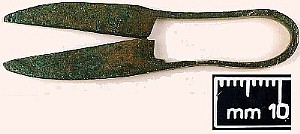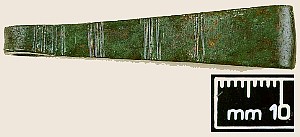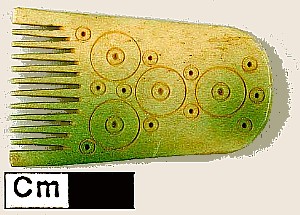|
|
Miniature Personal Items from Saxton Road, Abingdon: 6th century AD |
 Miniature Shears of Copper Alloy |
 Miniature Bronze Tweezers |
 Miniature Bone Comb |
Abingdon, at the confluence of the River Ock with the Thames, would have been an obvious location for a Saxon settlement. The cemetery at Saxton Road lies just south of the built-up area of the modern town, and gives evidence of a prosperous 6th-century settlement probably underlying it.
About two-fifths of the burials were cremations in urns, unusual in a cemetery of the West Saxons. A particularly unusual and interesting feature of the cremations was that certain personal items - shears, tweezers, knives and combs - were produced in a miniature size too small for use, and deposited with the ashes in the urn, but not cremated with the body and the rest of its clothing and jewellery. This suggests some ritual significance, and reminds us that later, in Medieval and early modern times in England, ornamental armour, weapons and caparison not fit for use were designed for important funerals, sometimes later being hung over the tomb.
The tiny shears are identical in form to the larger ones that would have been used by this community for shearing sheep and producing woollen cloth and clothing. Although they could have been used for very fine work or as nail shears, the blades could not have cut and were never used, still showing file-marks. These may have belonged to a male.
The tweezers are decorated with four bands of transverse lines, and were found in an urn also containing the little comb below, as well as burnt fragments of several beads, and so probably that of a female.
The comb has a very tall handle decorated with compass-designed dots and circles. It was found with the same cremation as the tweezers. Attention to hair combing and dressing was apparently a feature of Anglo-Saxon society despite the basic life-style in other respects. This emphasis is still found in the early Christian period when the differences in tonsure, or hair-style, between the (native) Celtic church and the newly imported fashion from Rome were the subject of major dissent.
© 1998 Oxfordshire Museum Service, Setúbal Museums and the Benaki Museum